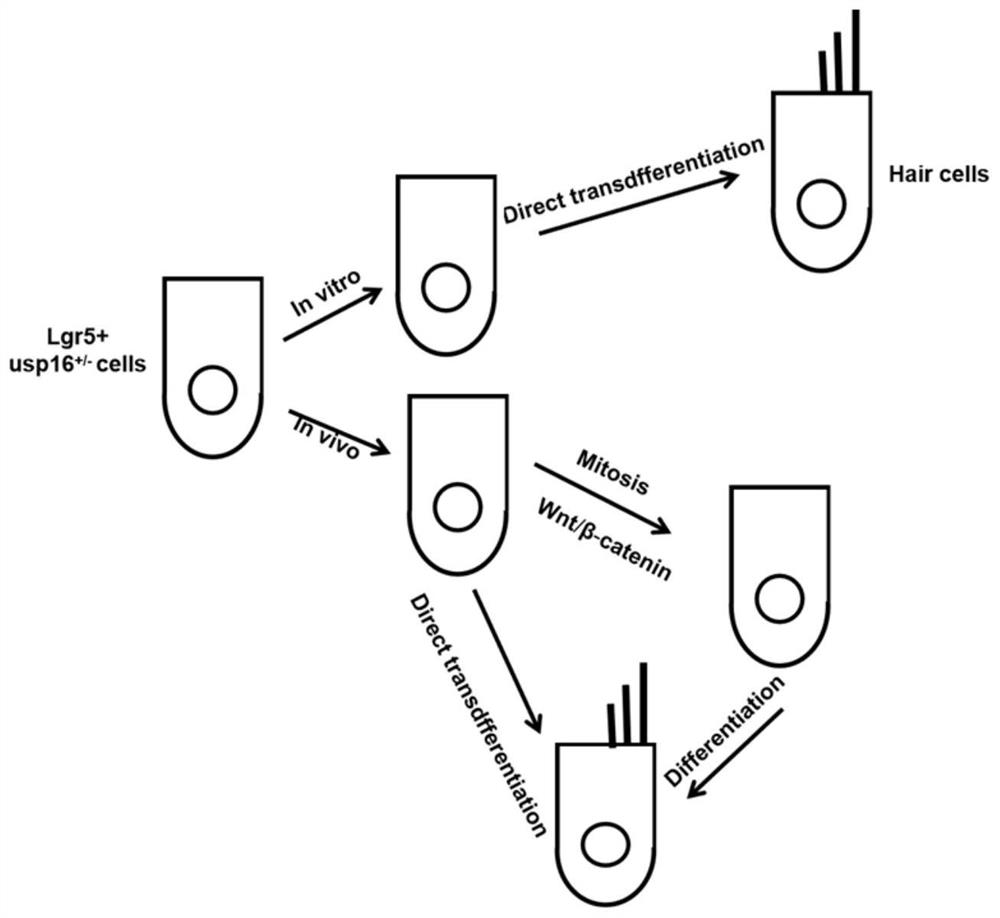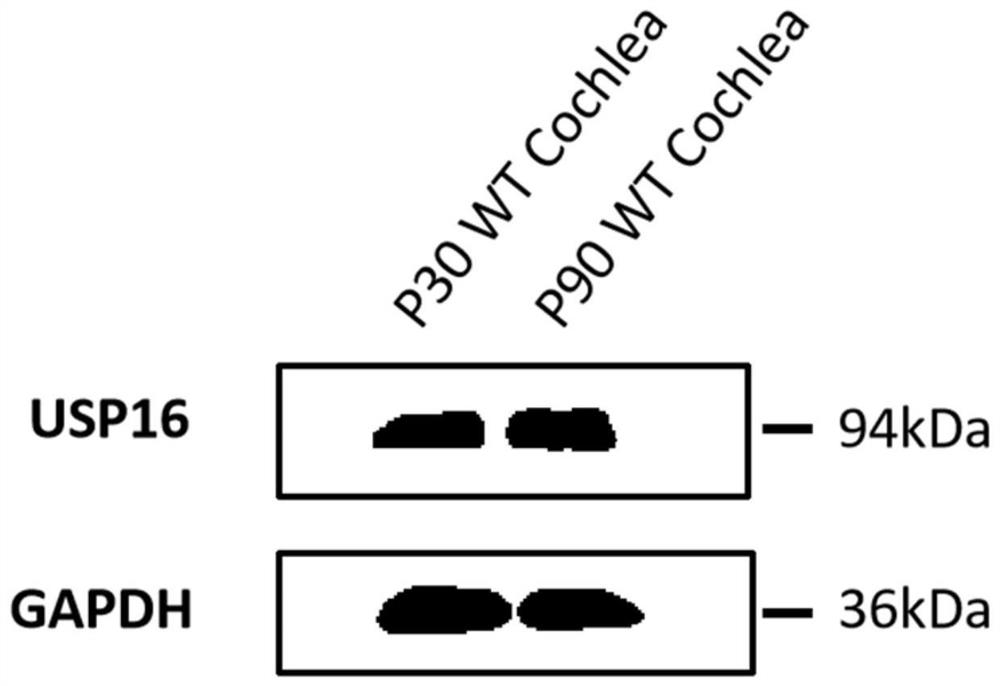Biological factor and application thereof in promoting regeneration of inner ear hair cells
A technology of biological factors and inner ear stem cells, applied in the field of biological inner ear research, can solve the problems that the effect has not been reported, and achieve the effect of regenerative recovery and great clinical application value
- Summary
- Abstract
- Description
- Claims
- Application Information
AI Technical Summary
Problems solved by technology
Method used
Image
Examples
Embodiment 1
[0041] Example 1 Spatiotemporal expression pattern of Usp16 gene in mouse inner ear
[0042] See Table 1 and Table 2 for the reagents and antibodies used below.
[0043] Table 1 Main Reagents and Drugs
[0044]
[0045]
[0046] Table 2 Antibody and dye information and dilution ratio
[0047]
[0048] 1. The expression of Usp16 gene in the inner ear:
[0049] a) Protein extraction:
[0050]Three P30 and P60 wild-type mice were selected, and the temporal bones were taken out quickly after the neck was broken, and the tissues were dissected in pre-cooled HBSS. Protease inhibitor cocktail of corresponding proportion (place the centrifuge tube on ice), then add 2 steel balls soaked in medical alcohol to each tube, grind in an ice-cold grinder until homogenized state, place on ice for 10min, and then carry out at 4°C Centrifuge (12000g, 10min); take the supernatant (about 280μL) into a new 1.5mL centrifuge tube, add 70μL 5×loading buffer; clip the explosion-proof clamp...
Embodiment 2
[0065] Embodiment 2 Knockout mouse preparation and identification method
[0066] GFI-cre and Lgr5-CreER mice were bred in this laboratory, and USP16-Loxp\Loxp mice were obtained from Jin Jin Laboratory, School of Life Sciences, Zhejiang University.
[0067] 1. Genotype identification of USP16-Loxp\Loxp mice
[0068] (1) Cut off the corresponding numbered toe of the mouse and put it into a 200 μL centrifuge tube, add 180 μL of 50 mM NaOH solution, and digest in a PCR instrument at 98 ° C for 1 hour. The tissue is thoroughly mixed. The primer sequences are as follows:
[0069] Table 3 USP1 6-Loxp mouse identification primers
[0070]
[0071] (2) PCR amplification system
[0072]
[0073] (3) PCR amplification program
[0074]
[0075] (4) DNA agarose gel electrophoresis and imaging: 6 μL of DNA Ladder (Vazyme, PM107-02), 10 μL of amplified product, 120V electrophoresis for 35 min, and photographed by the gel imaging system after completion.
[0076] (5) Genotype...
Embodiment 3
[0078] Example 3 Effect of Usp16 gene deletion on mouse hearing and inner ear structure
[0079] 1. Gfi-Cre, Usp16-loxp / loxp and Gfi-Cre, and Usp16-loxp / + knockout mice were obtained by crossing Gfi-Cre mice with Usp16-loxp / loxp mice. Cre The enzyme can specifically knock out the Usp16 gene in the middle of the two loxp sequences in the hair cells, so as to achieve the knockout effect. Unfortunately, the Usp16-loxp / loxp mice will die shortly after birth, so our Gfi-Cre , Usp16-loxp / + mice were subjected to ABR hearing test and immunofluorescence experiment of inner ear structure.
[0080] Parameters such as auditory response threshold, latency, and wave interval were detected by ABR, and short sounds (Click) and short sounds of different audio frequencies (especially high frequency and ultra-high frequency) were used as stimuli to analyze the hearing sensitivity of mice.
[0081] in,
[0082] Table 4 Main Instruments of ABR Test
[0083]
[0084]
[0085] The specific...
PUM
 Login to View More
Login to View More Abstract
Description
Claims
Application Information
 Login to View More
Login to View More - R&D
- Intellectual Property
- Life Sciences
- Materials
- Tech Scout
- Unparalleled Data Quality
- Higher Quality Content
- 60% Fewer Hallucinations
Browse by: Latest US Patents, China's latest patents, Technical Efficacy Thesaurus, Application Domain, Technology Topic, Popular Technical Reports.
© 2025 PatSnap. All rights reserved.Legal|Privacy policy|Modern Slavery Act Transparency Statement|Sitemap|About US| Contact US: help@patsnap.com



